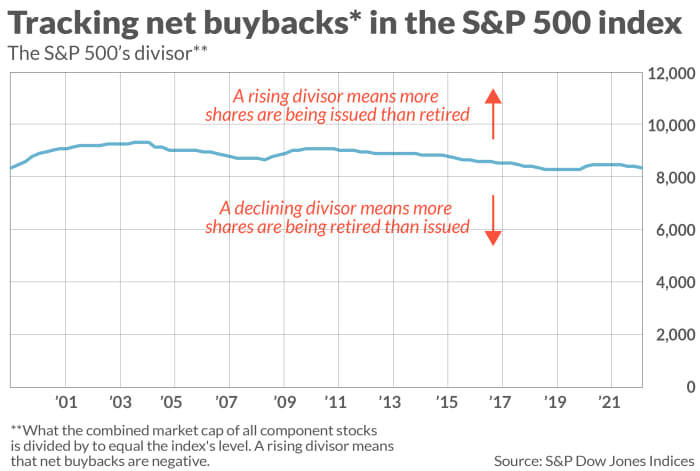The Biden administration’s new inventory buyback tax can have little impression on the general inventory market. it’d even actually assist it. I’m referring to the new 1% excise tax on share repurchases that went into impression on Jan. 1.
This tax has set off alarm bells in some corners of Wall road, on the idea that buybacks had been definitely one of many biggest props supporting the previous decade’s bull market — and something weakening that prop may finish in a lot decrease prices.
rather extra alarms went off after President Joe Biden telegraphed his intent to quadruple federal taxes on buybacks, to 4%.
be taught: Biden’s State of the Union: listed beneath are key proposals from his speech
whereas this proposal is taken into consideration lifeless on arrival on Capitol Hill, the give consideration to probably rising this tax from 1% reduces the likelihood which will most probably be eradicated anytime quickly.
Tax applies to web repurchases
but inventory-market bulls shouldn’t fear. One purpose is that the mannequin new excise tax — whether or not 1% or 4% — is utilized to web buybacks — repurchases in extra of what quantity of shares the company could have issued.
As has been broadly reported for years, the shares that many corporations are procuring for again typically are barely enough to compensate for the mannequin new shares they problem as an ingredient of their compensation of agency executives. in consequence, web repurchases — on which the mannequin new tax will most probably be levied — are an order of magnitude smaller than gross repurchases.
The chart beneath gives the historic context. It plots the S&P 500’s
SPX,
divisor, which is the quantity used to divide the mixed market cap of all part corporations to current you with the index stage itself. When extra shares are issued than repurchased, the divisor rises; the reverse causes the divisor to fall.

discover from the chart that, although there have been some 12 months-to-12 months fluctuations inside the divisor, the divisor’s finish-of-2022 stage was almost unchanged from the place it was on the elevated of the internet bubble.
there’s a lot irony inside the excise tax’s software to web repurchases. a lot of the political rhetoric that led to the creation of the tax was primarily based on the criticism that corporations had been repurchasing their shares merely to diminish again the share dilution which will in any other case happen when executives are given shares as an ingredient of their compensation packages. nonetheless it’s precisely when share repurchases equal share issuance that’s the tax wouldn’t apply.
The buyback tax would possibly encourage elevated dividends
the purpose why the mannequin new tax on share repurchases would possibly actually assist the inventory market traces to the impression it could have on corporations’ dividend coverage. Up till now, the tax code supplied an incentive for firms to repurchase shares reasonably than pay dividends as quickly as they wished to return money to shareholders. By no decrease than partially eradicating that incentive, corporations going forward may flip to dividends greater than they did beforehand. The Tax coverage coronary heart estimates that the mannequin new 1% buyback tax will finish in “a roughly 1.5 p.c enhance in agency dividend payouts.”
this would possibly be good information as a consequence of, dollar for dollar, a elevated dividend yield has extra bullish penalties than a elevated buyback yield. (The buyback yield is calculated by dividing per-share buybacks by share value.) to level this, I in contrast the predictive expertise of both yield. I analyzed quarterly knowledge again to the early Nineties, which is when the full quantity of buybacks on the market started to be important.
The accompanying desk experiences the r-squareds of regressions by means of which the utterly different yields are used to foretell the S&P 500’s return over the subsequent 1- or 5-12 months durations. (The r-squared measures the diploma to which one knowledge sequence explains or predicts one other.) discover that the r-squareds are markedly elevated for the dividend yield than for the buyback yield
| When predicting S&P 500’s return over subsequent 1 12 months | When predicting S&P 500’s return over subsequent 5 years | |
| Dividend yield | 4.2% | fifty 4.9% |
| Buyback yield | 1.zero% | 10.2% |
the underside line? whereas the mannequin new buyback tax is unlikely to have a large impression on the inventory market, the impression it does have may be extra constructive than unfavorable.
Mark Hulbert is a daily contributor to MarketWatch. His Hulbert scores tracks funding newsletters that pay a flat price to be audited. He may be reached at [email protected]
extra: Biden targets inventory buybacks — do they allow you to as an investor?
additionally be taught: The bond market is flashing a warning that U.S. shares may probably be headed decrease



0 Comments